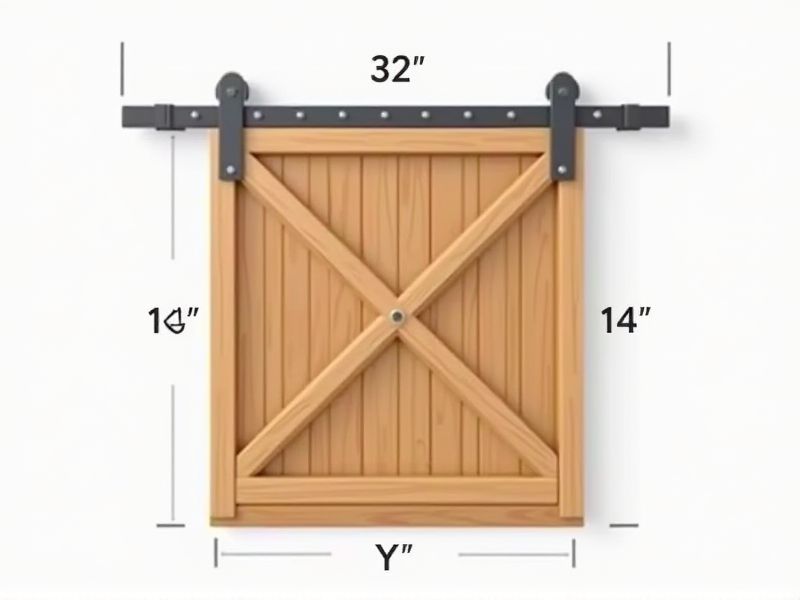
When considering the standard dimensions of a barn door, it's helpful to know that most interior barn doors are typically 36 inches wide and 84 inches tall, which is suitable for covering a standard doorway. However, door widths can range from 24 to 42 inches, depending on your space and needs, while heights might extend up to 96 inches for larger openings. It's important to measure your doorway and add an extra inch or two to both the width and height to ensure proper coverage and a finished look. Selecting the correct size not only enhances privacy but also improves the aesthetic and function of your barn door installation.
Height
The standard height for a barn door typically ranges from 80 inches to 96 inches, catering to various ceiling heights and aesthetic preferences. A standard width often varies between 36 inches and 48 inches, ensuring ample clearance for passage while maintaining the rustic charm of barn doors. When selecting a barn door, consider the mounting system, as a top-mounted track can add several inches to the overall installation height. Your choice in materials, like reclaimed wood or metal, can also influence the door's weight and functionality.
Width
The standard width for a barn door typically ranges from 36 to 42 inches, accommodating various interior designs while ensuring functionality. This width not only allows easy access but also complements the rustic aesthetic associated with barn doors. If you're planning to install a double barn door system, the total width can reach up to 84 inches or more, creating a striking visual impact. Keeping these dimensions in mind ensures your barn door project maintains both style and practicality.
Thickness
The standard thickness for barn doors typically ranges from 1.5 to 2 inches, providing a robust and durable construction suitable for various designs. This thickness ensures that the door remains stable and withstands the daily wear and tear of frequent use. You should consider that thicker doors not only offer enhanced soundproofing but also improve insulation, making them ideal for both interior and exterior applications. Selecting the right thickness can significantly impact the aesthetic appeal and functionality of your space, especially if you're aiming for a rustic or modern farmhouse look.
Material Type
Barn doors are primarily constructed from materials such as solid wood, engineered wood, and metal, each offering unique benefits. Solid wood provides classic aesthetics and durability, often showcasing natural grains and textures, while engineered wood offers cost-effective alternatives with enhanced stability. Metal, commonly used for hardware, adds a modern touch and is recognized for its strength and longevity. When selecting a barn door, consider the material's resistance to warping and humidity, especially in areas with fluctuating climate conditions.
Surface Finish
A barn door's surface finish significantly impacts both aesthetics and durability, with common materials including wood, metal, and glass. High-quality wood finishes, such as stain or paint, enhance the natural grain while providing moisture resistance, making them ideal for various climates. For metal barn doors, powder coating offers a robust, long-lasting finish that withstands scratches and corrosion, ensuring that the door maintains its appearance over time. Glass options, often framed in metal or wood, afford a modern look, while clear or frosted surfaces can enhance interior lighting and create a sense of spaciousness in your home.
Hardware Compatibility
When selecting a barn door, it's essential to consider hardware compatibility, as it directly influences functionality and aesthetics. Standard barn door hardware typically accommodates doors weighing up to 200 pounds, ensuring stability and smooth operation. Various track lengths are available, with common options ranging from 6 to 12 feet, allowing for versatile installation scenarios. Choosing the right hardware not only enhances the door's lifespan but also contributes to the overall decor of your space.
Weight
The standard weight of a barn door typically ranges from 50 to 150 pounds, depending on the material used, such as solid wood or metal. When selecting barn doors for your space, consider the weight, as heavier doors require more robust hardware and stronger tracks for proper operation. For a smooth and effortless glide, the weight of your barn door should be compatible with the specific track system installed, which typically supports 100 pounds or more. Ensuring that your chosen door is within the optimal weight specifications will enhance durability and ease of use in your home.
Panel Style
Barn doors with a panel style feature an appealing aesthetic that enhances both rustic and modern interiors. Typically constructed from solid wood, these doors can vary in thickness, generally ranging from 1.5 to 2 inches, providing durability and stability. Panel designs often include raised or recessed options, allowing for customization that suits your specific decor preferences. When selecting a barn door, consider a standard width of 36 inches, ensuring it fits seamlessly into your space while delivering a stylish focal point.
Insulation Properties
When considering a barn door's insulation properties, the U-factor is pivotal, ideally aiming for values below 0.3 for optimal energy efficiency. Insulated barn doors typically feature foam cores or double glazing, enhancing thermal performance by reducing heat transfer. In a standard 36-inch by 80-inch door, an insulated model can save you up to 30% on energy costs compared to a non-insulated counterpart. Proper weather-stripping and sealing further amplify insulation effectiveness, making these doors not only aesthetically appealing but also functional in maintaining indoor climate stability.
Color Options
Barn doors offer a variety of color options, allowing for customization to match your interior decor. Popular choices include classic shades like rustic brown, sleek black, and contemporary white, catering to diverse aesthetic preferences. With over 20 available colors, you can find the perfect hue that complements your space. Your selection can enhance the ambiance and style of any room, whether you prefer a vibrant pop of color or a more muted tone.
